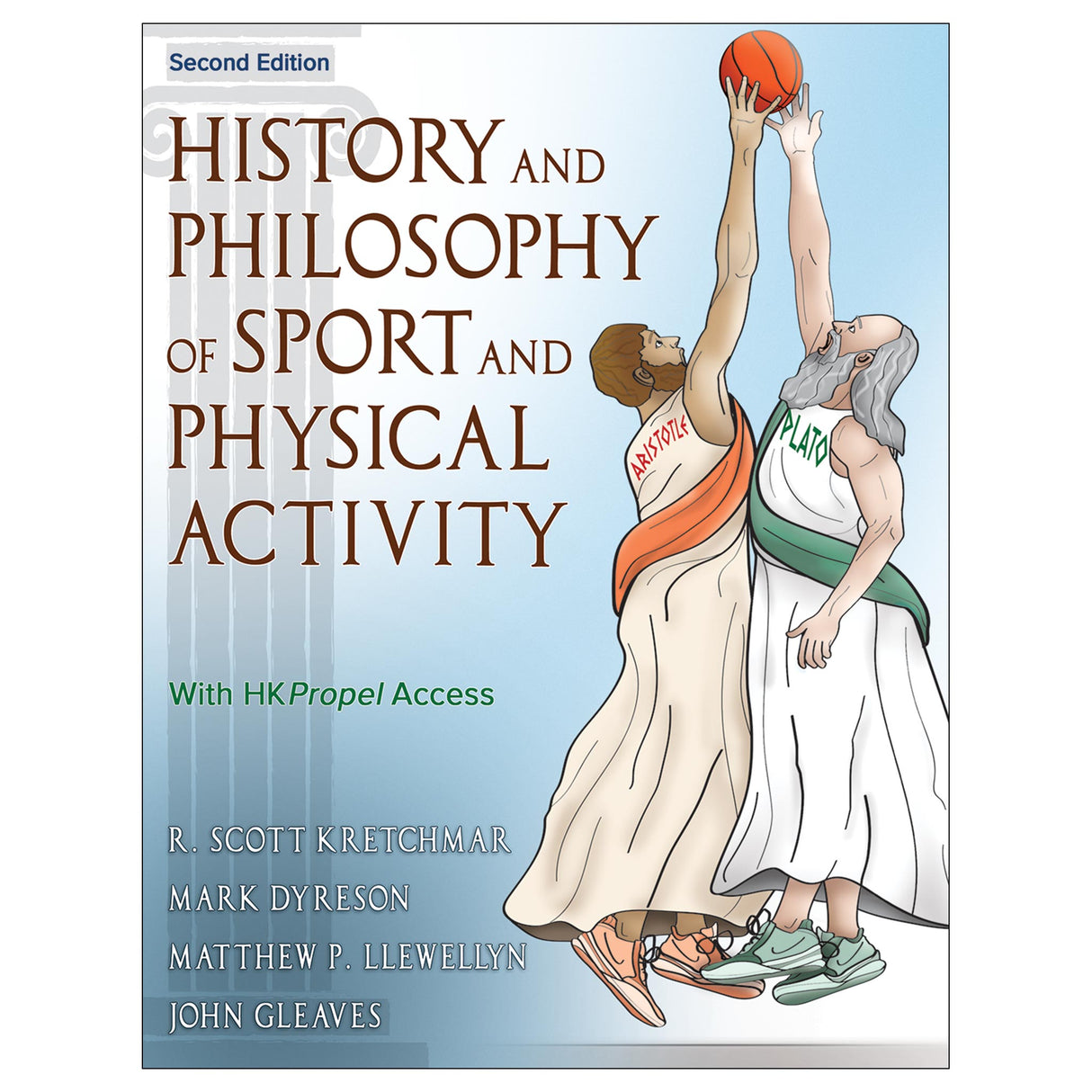History and Philosophy of Sport and Physical Activity 2nd Edition Ebook With HKPropel Access
$129.95 CAD

The second edition of History and Philosophy of Sport and Physical Activity is ideal for instructors who teach history and philosophy in a single course. Each chapter provides a historical scaffolding that leads into philosophical discussions about the issues raised. The text eschews dense blocks of text in favor of accessible writing and an interactive student experience.
Updates to the latest edition include expanded coverage of diversity, equity, and inclusion topics; a deeper exploration of epistemology; a discussion of alternate forms of physical activity; and new material about the ethics of research. Contemporary topics of discussion such as the Exercise Is Medicine (EIM) movement, athlete biodata collection, and transgender and nonbinary athletes in sport are thoroughly explored.
Discussion questions and study questions at the end of each chapter challenge students to reflect on the course material and share their ideas. Historical profile sidebars throughout the chapters allow students to gain greater insight into historical figures and events. Throughout the text, students are prompted to access related online activities in HKPropel. These short exercises connect philosophical inquiry to historical events and modern-day issues and serve as important tools for improving students’ reasoning skills. Instructors are supported with a comprehensive instructor guide that includes sample responses to the downloadable student exercises, section references for the downloadable study questions, and sample discussion and assignment prompts related to the discussion questions. The instructor guide also includes ideas and instructions for semester-long student projects.
History and Philosophy of Sport and Physical Activity, Second Edition, presents a thorough integration of philosophy and history, capitalizing on the strengths of both disciplines.
Note: A code for accessing HKPropel is included with this ebook.
Audience
A textbook for undergraduate students in kinesiology taking a foundations, philosophy, or history course on sport and physical activity; a reference for academic libraries and sport studies researchers. Also a resource for beginning professionals looking to gain historical and philosophical context on sport and physical activity.The Evolution of Kinesiology
The Humanities and the Sciences
The Nature of History and Philosophy
The Subject Matter of Kinesiology
Chapter 1. Bodies, Brains, and Cultures
Making Sense of Our Story
Developing a Brief Chronology of Our Story
Great Leaps Forward
Patterns of Culture in Hunter-Forager Societies
The Origins of Sport
The Complexities of Work and Play in Hunting and Foraging Societies
Chapter 2. The Transition From Super Endurance Predators to Farmers
A Revolution in How We Lived
The Impact of the Neolithic Revolution on Human Vigor and Health
Physical Activity as a Tool and as a Jewel
The Difficulties of Interpreting Ancient Sporting Cultures
A Model of Traditional Sport
Chapter 3. Ancient Greece and the Shape of Modern Sport and Physical Education
The Foundation of Western Civilization
Myth, Religion, and the Origins of Greek Physical Culture
The Birth of Philosophy
The Ancient Sporting Festivals
The Olympic Games
Greek Sporting Culture
Sources of Evidence for Ancient Greek Sport
Greek Recreation and Physical Education
Chapter 4. Continuity and Change in Physical Cultures
Monuments to Sporting Spectacles
Comparing Mesoamerican and Roman Spectacles of Blood
Opposition to Gladiatorial Contests
The Ethics of Brutality in Sport
Contrast and Continuity
The Enduring Martial Traditions
Religious and Intellectual Opposition to Martial Sports
Similarities and Differences Between Eastern and Western Sport
Global Continuities and Contrasts
Chapter 5. The Expansion of the West and the Birth of the Modern World
The Birth of the “Modern World”
The Renaissance, Neoclassical Revivals of Sport, and the “Nature of Man”
The Emergence of “Modern” Debates on Human Nature
The Protestant Reformation and Sport, Physical Education, and the Body
The Scientific Revolution and Modern Attitudes Toward Sport, Physical Education, and the Body
Chapter 6. Great Britain and the Birth of Modern Sport
Sport as a Critical Modern Institution
The Rationalization of Ethics Under Utilitarianism
Rationalization and Gambling
Games for the Common Folk
The Rationalization of Fair Play
Chapter 7. Liberty, Equality, Fraternity
The Emergence of Modern Sport
Liberty, Equality, and Morality
The Role of Fraternity in Modern Sport
Fraternity, Partisanship, and Spectatorship
Fraternity, Partisanship, and Commercialism
Chapter 8. Games and Empires
The Paradoxical Power of Sport
Conquest, Colonialism, and the Spread of Western Sport
Sport in Its Best Light
The Subaltern Dilemma
Sport as a Revolutionary Force
Sport, Colonialism, and American Imperialism
Chapter 9. The Rise of International Sportsworlds
Reviving the Olympic Games
Olympic Growing Pains
Social Exclusion and Other Harsh Realities of the Early Olympics
The Globalization of Modern Sport
Sport in Black and White and Technicolor
The Ethics of Commercialism
Chapter 10. The West and the Rest
Traditional and Indigenous Sport in an Age of Modernity
Western Appropriations of Eastern Muses
The Effectiveness of Folk Psychology and Folk Medicine
Encounters With the “Other”
Holistic Kinesiology
The Emergence of Countercultural Movement Practices
Chapter 11. The Golden Age of Modern Sport
Phenomenology
Cold War Sport
Modern Science and Sport
The Ethics of Performance Enhancement
Breaking Gender Barriers
Beyond the Gender Binary
The Cold War and the Politics of Race in American Sport
The Global Dimensions of Race and Sport
Sport in Living Color
Chapter 12. Snapshots From Our Times
Do Global Connections Create Global Identities?
Global Consumer Culture
The Emergence of New Global Forms
The Cold War and the Politics of Race in American Sport
The Difficulties of Interpreting Ancient Sporting Cultures
All ancillaries are free to adopting instructors through HKPropel.
Instructor guide. Includes a detailed plan for how to use the online student exercises and study questions, semester-long class projects, potential responses to discussion questions, and sample discussion or assignment prompts.
Test package. Contains questions in true-false, fill-in-the-blank, and multiple-choice formats. The files may be downloaded for integration with a learning management system or printed for use as paper-based tests. Instructors may also create their own customized quizzes or tests from the test bank questions to assign to students directly through HKPropel. Multiple-choice and true-false questions are automatically graded, and instructors can review student scores in the platform.
Chapter quizzes. Contains ready-made quizzes (10 questions each) to assess student comprehension of the most important concepts in each chapter. Each quiz may be downloaded or assigned to students directly through HKPropel. The chapter assessments are automatically graded, and instructors can review student scores in the platform.
Presentation package. Features PowerPoint slides of text, artwork, and tables from the book that can be used for class discussion and presentation. The slides in the presentation package can be used directly within PowerPoint or printed to make handouts for students. Instructors can easily add, modify, and rearrange the order of the slides.
Instructors also receive access to all student materials in HKPropel. For History and Philosophy of Sport and Physical Activity, Second Edition, this includes 38 student exercises, study questions with references to sections in the chapter where the answers can be found, and lists of recommended films, websites, and readings.





